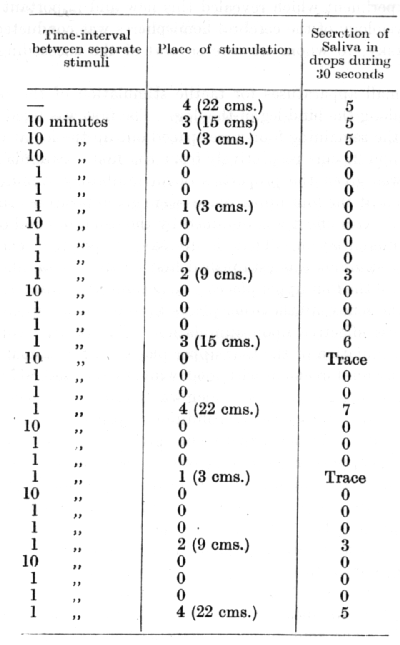 [p. 155]
[p. 155]An internet resource developed by
Christopher D. Green
York University, Toronto, Ontario
ISSN 1492-3173
(Return to index)
By Ivan P. Pavlov(1927)
Translated by G. V. Anrep (1927)
Posted March 2000
[Classics Editor's note: Pavlov used both square and round brackets in his texts. These have been preserved but can lead to confusions as to which insertions are the author's and which are the editor's. Page numbers, reference numbers, and the occasional "sic" have been inserted in square brackets by the Classics editor. All other insertions (e.g., on p. 31) are by Pavlov. -cdg-]
LECTURE IX
The irradiation and concentration of nervous processes in the cerebral cortex: (a) The irradiation and concentration of inhibition within a single analyser.
Up to the present we have been concerned chiefly with what may be called the external aspect of the cortical activity. We have studied the general laws governing the establishment of the most complicated and delicate correlations between the organism and its environment. It was shown that in response to an unlimited number of stimuli there can be brought about in the cerebral hemispheres an activity which serves to signal the approach of the comparatively small number of agencies which are of vital importance to the organism either in a favourable or in an injurious sense. It is through the hemispheres that corresponding reactions are brought about, thus anticipating the actual contact or clash of the organism with those agencies. The conditioned significance of stimuli is constantly corrected or changed by the hemispheres, so that when a given stimulus no longer corresponds to the correlations existing at a given time between the organism and its environment such a stimulus may be rendered temporarily or permanently ineffective. Finally, we have seen that in harmony with the perpetual and varied fluctuation of nature the hemispheres may invest with a rôle of conditioned significance on the one hand the minutest elements of the environment individually ("analysis"), and on the other band various complexes compounded of these elements ("synthesis").
The present and the following lectures will be devoted to the study of the internal aspect of the cortical activity, and we shall consider first the part played in it by the fundamental nervous processes of excitation and inhibition.
The first point which must receive our attention is the irradiation and concentration of these two processes.
It frequently happens in physiological investigation that where a broad group of phenomena is to be examined, the investigation of one of the members of this group may be more convenient than that of others. A detailed investigation of this aspect of internal [p. 153] inhibition proved, in the present case, to be the most advantageous. At the same time this investigation provided a striking illustration of the numerous advantages presented by the cutaneous analyser with its extensive and easily accessible receptor surface.
The experiment which revealed this new and important chapter in the physiology of the cerebral hemispheres was conducted by Dr. Krasnogorsky, to whom we owe several of the succeeding experiments.
Five small apparatuses for tactile stimulation of the skin were arranged along the hind leg of the dog. The first was fixed over the paw, and the remaining four were spaced out up the leg at distances of 3, 9, 15 and 22 cms. respectively from the first. Stimulation over the paw was given the properties of an inhibitory stimulus, while stimulations at the four upper places were given positive conditioned properties. This effect was obtained by the usual method of experimental differentiation. That is to say, a positive conditioned alimentary stimulus was established first of all to a tactile stimulation of one of the four upper places; on account of the initial generalization of the reflex, all the other places as well became spontaneously more or less effective upon stimulation. The positive conditioned effect of stimulation of the four upper places on the animal's leg was equalized by reinforcement with food, while by the method of contrast the stimulation over the paw, which was given always without reinforcement, lost all its positive conditioned properties and acquired inhibitory ones. In the experiments given below the conditioned stimulus was applied in every case during 30 seconds. The place on the skin which was stimulated is indicated by a number: 0 represents the inhibitory place ; 1, 2, 3, 4 represent the positive places taken in order. The number of the positive place is accompanied by a figure giving its distance from the inhibitory place.
It is seen from the table (p. 154) that stimulation of each of the three places 4, 3, and 1 produced in the beginning identical positive conditioned effects, measured by 5 drops of salivary secretion during 30 seconds. The four places 1, 2, 3 and 4 were now separately tested at an interval of exactly one minute after the last of three successive applications of the inhibitory stimulus. The stimulation of place 1, nearest to the inhibitory place, was at the first test absolutely ineffective, and at the second test its effect was barely distinguishable (less than one drop). The stimulation of place 2, next in distance from the inhibitory place, gave only half its normal [p. 154] positive conditioned effect, but the stimulation of the remaining places (3 and 4) gave a full or even an increased positive effect. The significance of this experiment is clear. The different sensory places on the skin must be regarded as projecting themselves upon corresponding areas in the cortex of the hemispheres. Therefore it is reasonable to suppose that the inhibitory process initiated in a definite point of the cortex by the tactile stimulation of the inhibitory place irradiates into the surrounding region, giving a smaller inhibitory effect with increase of distance from the inhibitory point and becoming indistinguishable at the more distant points.
 [p. 155]
[p. 155]
A different intensity of the inhibitory process can be produced, either by varying the number of successive applications of the inhibitory stimulus, of which the after-effects are summated, or by varying the interval between the last inhibitory stimulus and the application of thc positive stimulus. In either case different figures are obtained for the salivary reflex, but their general significance remains the same. This is shown in the following experiment:
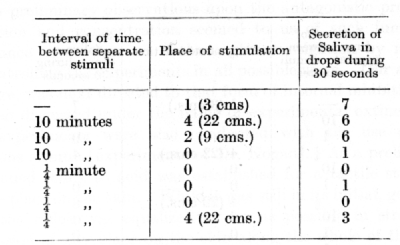
The inhibitory after-effect was tested in this experiment after a shorter time (1/4 minute), and after four applications of the inhibitory stimulus instead of three; under these conditions a considerable inhibitory influence was exerted even upon the positive place 4, which is the previous experiment when tested one minute after three successive applications of the inhibitory stimulus gave a full reflex.
If the various positive stimuli are applied in one and the same experiment at different times after the last inhibitory stimulus, it can clearly be brought out how the initially widely irradiated inhibition gradually frees from its after-effect first the remoter areas, and subsequently those areas nearer to the cortical point in which the inhibition arose primarily. An example of such an experiment is given in the table shown on p. 156.
It is thus seen that the furthest place (4) was free of inhibition after half a minute, place 2 after five minutes, and place 1 after ten minutes.
The more frequently the differentiation is exercised in the course of days or weeks, the more rapidly are the more remote places freed from the inhibitory after-effect, a fact which is sometimes exhibited [p. 156] in thc course of a single experiment after the positive and negative stimuli have been repeated several times.
It is worthy of note that experiments upon the irradiation of inhibition have been successfully demonstrated on numerous occasions without serious interference by the presence of a stranger with the experimenter in the animal's room, and have even been carried out successfully at crowded meeting of the Petrograd Medical Society.
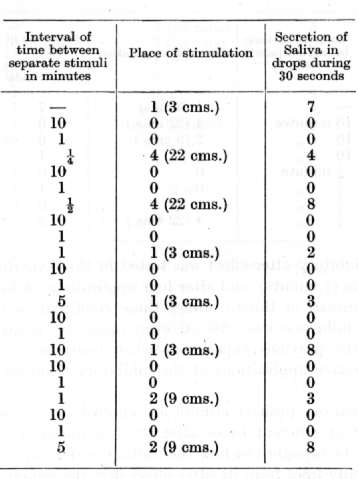
We have now to inquire into the nature of the recession of inhibition from those cortical points into which it was irradiated. Does this represent a destruction or waning of the inhibition in these places, or is it some kind of return or active concentration of the inhibition to its starting-point due to some antagonistic process? In face of the constant fact that strengthening of differentiation by repeated contrasts is accompanied by corresponding shortening of the duration and extent of irradiation of the inhibitory after-effect, we are naturally more inclined to accept the second hypothesis, [p. 157] namely, that we deal with the reverse of irradiation, i.e. "concentration" of the inhibition toward its initial point of origin in the cortex. A number of important facts in support of this conclusion will be adduced later. Meanwhile, it may be noted that in Dr. Krasnogorsky's experiments the waning of the inhibition occupied several minutes. The actual spread of inhibition, however, proceeded with such rapidity in these experiments that Dr. Krasnogorsky was unable to follow it.
The preliminary observations upon the antagonistic processes of irradiation and concentration seemed to us of such fundamental importance as to demand a thorough investigation by modifying and controlling the experiments in all possible ways. Our attention, therefore, was next directed to that form of internal inhibition which bas been discussed under the name of experimental extinction, and these experiments were also conducted with the use of tactile cutaneous stimuli [experiments of Dr. Kogan]. As a preliminary a conditioned reflex to acid was established for a tactile stimulation of some place on the akin. While it was still in its initial, generalized phase the reflex was equalized as far as possible in strength for stimulation of any place on the skin along the whole of the surface of one side of the body before the experiments were proceeded with. A definite place was then selected to which the stimulus was applied for a minute, without reinforcement, and repeated every two minutes until the first zero was obtained. At different intervals of time, following the first zero of extinction at the given place, tactile stimulations were tried at various other places of the skin and the resulting secretory effect was compared with their usual one. These other places were found also to suffer inhibition temporarily to a greater or less extent. The place subjected to experimental extinction is termed the place of primary extinction, and the places which become involved in the inhibitory after-effect are termed places of secondary extinction. We are familiar with this terminology from our discussion of the phenomenon of experimental extinction in the fourth lecture, where it was made quite clear that the extinctive inhibition does not confine itself to the actual point in the cortex which was called into activity by the specific external stimulus, but irradiates over a wide area. We have, in other words, a phenomenon similar to that which has already been discussed in connection with differential inhibition.
It was essential in these experiments to vary the place subjected [p. 158] to the primary extinction. Otherwise, instead of the extinctive inhibition-from which the primarily extinguished reflex frees itself in a few minutes, or the most 1-2 hours -- there would have developed a differentiation with its very stable and lasting form if internal inhibition.
An example of an experiment such as has just been described is given in the following table:
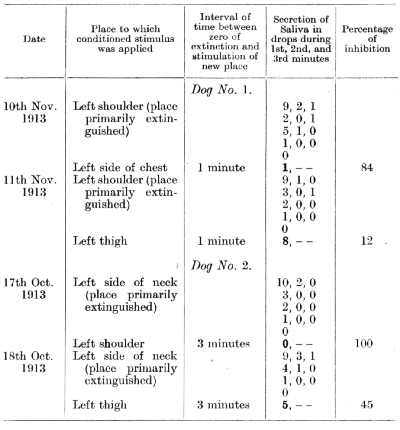
It is plain that the further away on the skin the secondarily inhibited place is from the place which undergoes the primary inhibition, the weaker is the irradiated inhibitory after-effect.
If the stimulation is applied to one definite place at different intervals of time after the reflex has been extinguished to zero at [p. 159] another place, the greater this interval the weaker is the inhibition in the secondarily extinguished place. This is borne out by the following experiments.

It is obvious that in this experiment we deal again with the concentration d inhibition, the inhibition being gradually withdrawn from the periphery of its irradiation and concentrated at its [p. 160] initial point. Further, it becomes evident that the rate at which the inhibition is withdrawn from the places undergoing secondary inhibition varies very considerably with individual dogs, so that, for example, a process which occupies only one minute in dog No. 1 requires fifteen minutes in dog No. 2. This, of course, is a fact of considerable importance, since it gives a numerical expression to one of the most intimate sides of the highest nervous activity. That these individual differences in the three animals were not accidental is shown by the fact that they remained constant during many months in which the experiments proceeded.
In the experiments of Dr. Kogan it was possible to observe also the progress of the spreading Of the inhibitory after-effect. I shall give the actual experiments in which the degree of secondary inhibition corresponding to the different places of the skin was determined immediately after complete primary extinction had been obtained:
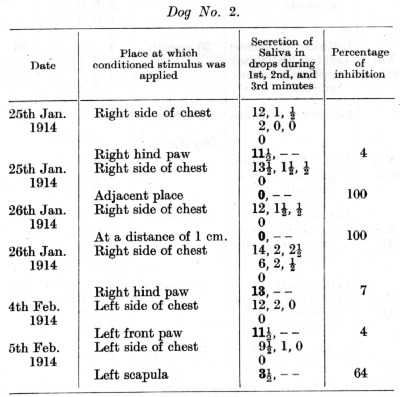
A comparison of these results with those of the preceding experiment on the same dog shows clearly that immediately after the full [p. 161] development of inhibition for the primarily extinguished place, a complete secondary inhibition is obtained only for adjacent places, the inhibitory after-effect being absent or hardly distinguishable for places more remote.
It is interesting to note that in the three dogs employed in these experiments the effect of stimulating the remoter places immediately after the primary inhibition had been produced varied considerably. In dog No. 1 not only was the reflex to stimulation of the remoter place not inhibited, but it even produced a considerably enhanced positive effect, whereas dog No. 3 under similar conditions revealed a considerable degree of secondary inhibition. This fact, which was frequently observed in the experiments both of Dr. Krasnogorsky and Dr. Kogan, and which will form the subject of more detailed discussion in the eleventh lecture, is well illustrated in the following experiments:
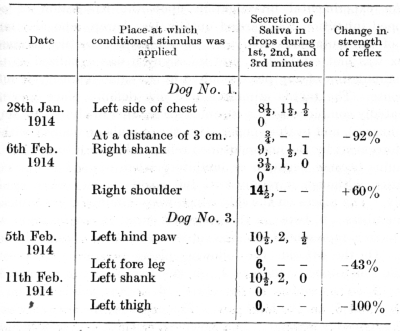
In addition to the foregoing, Dr. Kogan made a considerable number of observations which illustrate in detail the length of time occupied in his three dogs by the phases of irradiation and concentration of inhibition in the tactile cutaneous analyser. These observations show that in the case of dog No. 1 the phase of irradiation of inhibition occupied about twenty seconds, while the concentration [p. 162] of inhibition occupied about seventy-five seconds. In dog No. 2 the irradiation was complete after three minutes, while the whole inhibitory process in both its phases occupied fifteen minutes. In dog No. 3 the corresponding figures were four to five minutes for the irradiation and twenty minutes for the two phases taken together. It is seen, therefore, that although the duration of the inhibitory after-effect differed considerably in the three dogs, the time ratio between the phases of irradiation and concentration of the inhibition remained almost constant, the phase of concentration taking four or five times as long as the phase of irradiation. It must be admitted, however, that the data relating to the experiments upon extinction cannot be regarded as absolutely faultless, since the original magnitude of the conditioned reflexes sometimes varied considerably in different experiments, and in some cases the causes of these variations could not be definitely determined.
An experimental investigation upon the irradiation of conditioned inhibition was carried out by Dr. Anrep, who also made use of the cutaneous analyser. A generalized tactile cutaneous reflex was first established, and its strength was equalized so that the stimulation of any place resulted in the same intensity of reflex response. The tactile stimulation of one definite place was now repeatedly combined with a stimulus for another analyser (the sound of a buzzer), and in this combination the stimulus remained without reinforcement by the unconditioned reflex. The result was that the stimulus became negative or inhibitory when applied in the combination, although it retained its full positive effect when applied singly. The places on the skin which were stimulated are indicated by numbers: 0, between the neck and chest, in combination with the buzzer, represented the area subjected to the conditioned inhibition. On the left side the following places were used for positive tactile conditioned reflexes: 1, on the fore limb; 2, on the fore paw; 3, on the middle of the chest; 4, on the pelvis; 5, on the thigh; and on the hind paw. The experiments were conducted in the following manner. In a given experiment one positive place was first tested, in order to determine the normal magnitude of the conditioned reflex response. The inhibitory combination was now applied, and then the positive place was tested again at different intervals of time. This procedure was performed in separate experiments for all the remaining positive places. The positive and the negative conditioned stimuli were allowed to act in every case [p. 163] during 30 seconds. The following table summarizes the series of experiments on this animal:
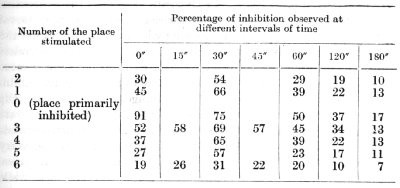
The first vertical column gives the number of the places stimulated; the succeeding vertical columns indicate the magnitude of inhibitory after-effect corresponding to these places. The upper horizontal row gives the length of the interval from the end of the inhibitory stimulus to the beginning of the stimulation of any given place.
It is thus seen that in the case of conditioned inhibition the inhibitory process initiated at a definite point spreads over the whole analyser, diminishing in intensity with distance from the primarily inhibited place, and reaching its maximum strength for the whole analyser only by the end of s period of 30 seconds ; after this the inhibitory process undergoes s gradual diminution-again simultaneously over the whole analyser. The only exception which must be made to this general rule is that at the place which is subjected to the primary inhibition the intensity of the inhibitory after-effect does not increase gradually, but is maximal from the start.
Of course, in these experiments also it was essential to take most rigid precautions to avoid casual extraneous stimuli, since these would invariably exert a disturbing influence causing sometimes inhibition of the positive reflexes and sometimes die-inhibition. Dr. Anrep's experiments were, however, performed in our special laboratory.
The three series of experiments, upon the movement of differential inhibition, experimental extinction and conditioned inhibition, all clearly demonstrate that the inhibition first spreads from its point of initiation over the whole analyser and then gradually recedes. The details of this process, however, are seen to differ considerably according to the type of internal inhibition. In Dr. [p. 164] Krasnogorsky's experiments on differential inhibition the irradiation of inhibition occurs instantaneously, and the inhibitory after-effect attains its maximum after a zero interval: it is only the concentration of inhibition in this case which proceeds in a measurable interval of time. In Dr. Kogan's experiments with extinctive inhibition the irradiation of inhibition was progressive, and the nearer places underwent the maximum secondary inhibition much sooner than the more remote places. The phase of concentration in the extinctive inhibition, however, was four to five times longer in duration than the phase of irradiation. It is possible that this difference of rate between the irradiation of these two forms of inhibition depends upon the intensity of inhibition developed. Dr. Krasnogorsky usually repeated the primary inhibitory stimulus several times, regardless of the fact that it produced its full effect at once, while Dr, Kogan confined himself to the first zero. The differences in the case of conditioned inhibition are much more complicated and important. Dr. Anrep showed that the conditioned inhibition, like the differential inhibition in Dr. Krasnogorsky's experiments, irradiated simultaneously, although in a varying degree, over the entire analyser; after this, in contradistinction from Dr. Krasnogorsky's results, the inhibition increased gradually up to a certain maximum strength during a definite period, and at all places simultaneously. The gradual diminution in intensity, of the inhibition also occurred simultaneously over the entire analyser. Thus conditioned inhibition differs from differential inhibition and from experimental extinction in that the entire analyser simultaneously reveals, though in different degrees, an inhibitory after-effect; an actual progression or regression of the maximum inhibitory after-effect cannot be observed.
The experiments by Dr. Anrep embrace in detail the following phenomenon, already indicated in pert by some previous workers. He observed that both positive and negative conditioned reflexes established to tactile stimulation of different places on one side of the body are reproduced spontaneously and with extreme accuracy to tactile stimulation of the corresponding places on the other side. The irradiation and concentration of the inhibitory after-effect once initiated on one side, correspondingly and equally involves the other side. This interesting fact will be discussed further on in these lectures.
A series of experiments analogous to those carried out on the irradiation of inhibition over the cutaneous analyser were conducted [p. 165] with the acoustic analyser, and these also confirmed the hypothesis that the peripheral end of the analyser can be regarded as projected geometrically upon the cortex of the hemispheres. In these experiments different musical tones, the beat of a metronome, and a hissing sound served as conditioned stimuli [experiments of Drs. Manuilov and Ivanov-Smolensky]. The reflex to one of these conditioned stimuli was subjected to primary experimental extinction, and the effect upon the reflexes to the remaining stimuli was observed. The following is an account of the experiments of Dr. Ivanov-Smolensby on this subject.
Separate conditioned alimentary reflexes were established, and equalized, to four different tones produced by a Max-Kohl's tone-variator. These tones were chosen in two pairs, separated by an interval of approximately three octaves -- the lower tones having vibration frequencies of 123 and 132 respectively, and the upper tones of 1036 and 1161 respectively. Similar reflexes were also established to a hissing sound, and to the sound of a metronome beating at a rate of one hundred per minute. In the course of the experiments one of the conditioned reflexes was extinguished to zero, and then all the remaining reflexes were tested in different experiments, either immediately or after intervals of 1, 3, 5, 7, 10, 12 or 15 minutes. All the reflexes were found to undergo secondary inhibition, but in a varying degree. A part of the results of these experiments is given in the table on page 166.
The table shows that on the extinction of one of the tones belonging to the lower pair the reflex to the other tone of the same pair reaches the maximum inhibition somewhat more rapidly, remains at this maximum longer, and recovers from the inhibition more slowly, than the reflexes to either of the higher tones. On the extinction of one of the high tones, the reflex to the other high tone reaches the maximum inhibition more rapidly, remains longer at this level, and recovers from the inhibitory after-effect more slowly than the reflexes to either of the lower tones. On the extinction of any of the tones the secondary inhibition of the reflexes to hissing and to the metronome is in all respects less than that of the reflexes to the tones. On the other hand, after extinction of the reflex to hissing or to the metronome an intense secondary inhibition of all the reflexes to tones is obtained.
It is obvious that only the experiments with extinction of tones can be brought forward as evidence of a definite geometrical [p. 166] projection of the acoustic peripheral receptor upon the cortical part of the analyser.
The fact that extinction of the reflexes to the metronome and to hissing produces intense inhibition of the reflexes to tones, whereas extinction of the reflexes to tones results only in comparatively weak inhibition of the reflexes to the metronome and hissing may perhaps be accounted for by the greater strength and by the more mixed character of the latter stimuli.
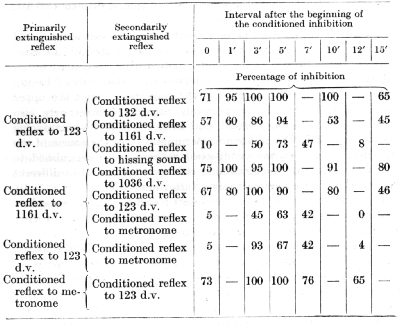
It is highly probable that irradiation and concentration of inhibition, which takes place as described in the cutaneous and acoustic analysers, follow a similar course also in thc case of other analysers. However, the experimental determination of the relationships in these cases is at present extremely difficult or even impossible owing to purely technical obstacles. If in the future these obstacles should be overcome and the laws governing the spread of inhibition be determined for all the analysers, an experimental method would be provided for the study of the internal structure of the different analysers.